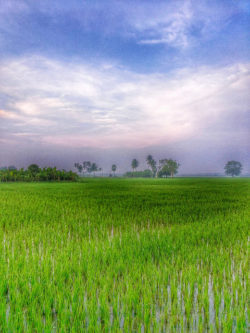by Nitya Priya S
A part of my extended family lives in a small village in southern India. This is where my husband and I decided to spend a day recently. A visit to the ancestral house and a bonding session with the relatives were long overdue. So, we resolved to keep an eye on the yearly holiday schedule to make this journey during the appropriate long weekend.
After a comfortable overnight train journey, we arrived in the bustling temple-town of Kumbakonam, which also served as the nearest economic centre for the surrounding villages, including ours. A taxi was pre-arranged and we soon found ourselves driving through snaking paths flanked by verdant paddy fields, which glinted as they bathed in the rays of the morning sun.
There is no clear demarcation for where the town ends and the village begins, geographically speaking. However, a good indication is the moment when one suddenly realises the expansiveness of the views around – the sprawling fields and the un-hindered skies indeed refresh the mind and heart. The route is peppered with sights of quaint, thatched houses, a lone temple at the curve of the road with its deity protecting the passers-by, small shops catering to the needs of the nearby residents, canals channelling the cool and calm river water to the green fields and the dam shutters regulating its flow. For a city-dweller, though, the unmistakable indication that one is entering the ambit of the village is the loss of mobile network. It is not sudden, mind you. As the road progresses, the network starts to exhibit intermittence and, on reaching the village, it is conspicuously absent. One loses the urge to constantly check email, WhatsApp and other social media updates because repeated attempts to access the internet makes you realise that it is an utterly pointless and unrewarding exercise.
We passed a water pump and turned a corner to enter the street where my ancestral house was situated. It was a street guarded by the gods, so to speak. On approach and to the right was the recently renewed temple dedicated to Lord Shiva, with its gopuram or tower adorned with colourful figures of gods and goddesses. Standing here and looking ahead, one could clearly spot the dark inner sanctum of the temple dedicated to Lord Vishnu at the other end, which also marked the point where the road forked.
A row of traditional clay-roofed houses with a raised porch called ‘thinnai’ lined the street. We could also spot a few modern dwellings with gates and terraces, which were recent additions. While most of the houses were occupied, there were a few that were empty and have been empty for as long as I can remember.
It was a quiet street and the silence was broken by the noise of our car, which pulled over right in front of my ancestral house. As we alighted, I could see a few of my relatives walk towards the open door, thrilled at our arrival and eager to help with our luggage. The smiles on their faces made for a very warm welcome.
We chatted with our relatives and had a sumptuous, hearty meal. The members then retired for their afternoon siesta. Inured to a life of constant connectivity, it was not long before my husband and I found ourselves wondering how we would spend the rest of our time. Away from the seductive pulls of the internet, our options were severely constrained. We then decided to indulge ourselves and take a walk. Free from the urban concerns of pollution, pedestrian safety and blaring vehicle horns, we ambled along quiet roads, around an orchard, beside the rivulet, watching the hoopoes, sparrows, peacocks and peahens go about their daily business of life.
The silence of the surroundings was almost otherworldly. Ears tuned in to the rustle of leaves, flapping of wings, splashing of water and breaking of twigs. The eyes were riveted on the sight of a bird hovering and then gliding effortlessly over water before touching down. It was the epitome of balance.
We sat by the rivulet. The water’s apparent stillness belied steady movement – of its ripples and its calm flow in the direction of the current’s pull. This could be said of life in the village too. Houses may be abandoned, streets may look empty, but for the people who have chosen to continue this way of living – for those who have not given in to the lure of the city – life goes on as always. Some work in the kitchen to feed the family, or outside home tending to shops, crops and cattle. Some work in nearby towns and commute daily. Some just sit and watch the world go by.
To a city dweller vacationing in the village, it may feel as though nothing happens there. One could feel so bored that one would have to actually engage with boredom. The slow pace of life may trigger a Fear-Of-Missing-Out syndrome, as it sometimes does for me. Yet, there is something to be said for the meditative focus the rural milieu lends itself to.
Oh, I must also mention the irony in finding mobile network near the scenic rivulet.
Picture from https://www.flickr.com/photos/sunishsebastian/





